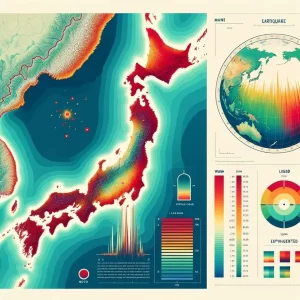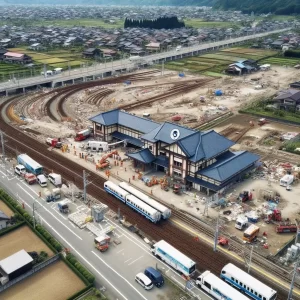Contents
- 1 Introduction:
- 2 Ishikawa Earthquake 2024 Seismic Landscape: Understanding Tectonic Patterns
- 3
- 4 Event Timing and Scale:
- 5 Ishikawa Earthquake 2024: Timely Response and Scale Assessment
- 6 Tracing Japan’s Seismic History: Lessons from Past Quakes
- 7 Emergency Mobilization: Swift Reaction to Ishikawa’s Quake
- 8 Human Cost and Infrastructure Impact: Assessing Ishikawa’s Toll
- 9 Ishikawa’s Vulnerability: Seismic Susceptibility and Historical Risks
- 10 Global Response to Ishikawa Earthquake 2024: International Repercussions and Tsunami Warnings
- 11 Evaluating Damage: Infrastructure Challenges Post-Ishikawa Quake
- 12 Future Challenges: Ensuring Nuclear Safety Post-Earthquake
- 13 Rescue Operations: Responding to Ishikawa Earthquake’s Aftermath
- 14 Beyond Destruction: The Human Element in Ishikawa’s Recovery
- 15 Japan’s Resilience: A Conclusion to Ishikawa Earthquake Response
- 16 Author
Introduction:
The Ishikawa Earthquake 2024 is a defining event in Japan’s seismic history, emphasizing the nation’s vulnerability to earthquakes and testing its disaster response strategies. This article offers an in-depth look at the Ishikawa Earthquake 2024, analyzing its geographic setting at the intersection of four tectonic plates and its significant regional impact. We also explore Japan’s historical experiences with earthquakes, focusing on the recent event near the Noto Peninsula. Additionally, the article addresses the intricate recovery efforts underway, highlighting Japan’s resilience. Understanding the Ishikawa Earthquake 2024 is crucial for grasping the complexities of Japan’s tectonic dynamics and its preparedness for future seismic challenges.
Ishikawa Earthquake 2024 Seismic Landscape: Understanding Tectonic Patterns
Striking at approximately 4 pm local time, the Ishikawa earthquake 2024 shook the Noto Peninsula, boasting a formidable 7.6 magnitude. Its potential for extensive destruction prompted immediate tsunami alerts for Japan’s west coast and neighboring regions, including South Korea. Given Japan’s history with catastrophic earthquakes, swift responses to these alerts are imperative for mitigating harm and devastation.

Event Timing and Scale:
The Ishikawa Earthquake 2024 struck with unexpected precision at 4 pm local time, transforming the peaceful Noto Peninsula. This significant 7.6 magnitude earthquake tested the resilience of local communities and captured the attention of global seismologists and disaster response teams. The event’s timing highlights the unpredictability of seismic activities in Japan, a nation accustomed to tectonic movements. The earthquake’s scale, indicative of potential widespread destruction, marked a critical chapter in Japan’s ongoing battle with seismic threats. Following the earthquake, the issuance of tsunami warnings exemplified the urgent need for effective disaster response, reflecting a balance between historical understanding of earthquakes and the necessity for immediate, life-saving measures.
Ishikawa Earthquake 2024: Timely Response and Scale Assessment
Striking at approximately 4 pm local time, the Ishikawa earthquake shook the Noto Peninsula, boasting a formidable 7.6 magnitude. Its potential for extensive destruction prompted immediate tsunami alerts for Japan’s west coast and neighboring regions, including South Korea. Given Japan’s history with catastrophic earthquakes, swift responses to these alerts are imperative for mitigating harm and devastation.
Tracing Japan’s Seismic History: Lessons from Past Quakes
Japan’s seismic chronicles are marked by numerous catastrophic events, with the 2011 Great East Japan Earthquake being a poignant example. A disaster of 9.0 magnitudes, it unleashed a tsunami and led to the Fukushima nuclear incident, claiming around 20,000 lives and inflicting significant economic damage. The Ishikawa earthquake 2024 serves as a stark reminder of these past tragedies, emphasizing the continual need for effective disaster preparedness.
Emergency Mobilization: Swift Reaction to Ishikawa’s Quake
In the aftermath of the Ishikawa earthquake, Japan’s government swiftly activated its emergency systems. The Japan Meteorological Agency issued various tsunami warnings, triggering evacuations across nine prefectures and affecting nearly 100,000 people. These evacuations played a crucial role in ensuring immediate safety and support during the crisis.

Human Cost and Infrastructure Impact: Assessing Ishikawa’s Toll
The aftermath of the Ishikawa earthquake 2024 has been devastating, with a reported minimum of 30 fatalities. Rescue teams are tirelessly working to extricate individuals trapped under debris, and the death toll may escalate as operations progress. Infrastructure damage, including compromised roads, has added complexity to the ongoing rescue efforts.
Ishikawa’s Vulnerability: Seismic Susceptibility and Historical Risks
Ishikawa, renowned for its cultural significance and tourism appeal, is exceptionally vulnerable to earthquakes due to its proximity to tectonic plate boundaries. The Ishikawa earthquake stands as the most significant seismic event in this area since 1885, underscoring the historical seismic risk inherent in the region.
Global Response to Ishikawa Earthquake 2024: International Repercussions and Tsunami Warnings
The Ishikawa Earthquake 2024’s impact resonated globally, transcending Japan’s geographical boundaries. Its seismic waves prompted immediate international responses, particularly from neighboring regions. Russia, North Korea, and South Korea, along with the Russian island of Sakhalin, were quick to issue tsunami warnings in anticipation of aftershocks. In Russia, precautionary measures included recalling fishermen from vulnerable waters. South Korea’s response was marked by evacuation orders following the detection of a 0.67-meter tsunami wave. These actions underscore the earthquake’s significant international implications, highlighting a shared understanding of the potential threats posed by such powerful seismic events. This collective vigilance reflects an evolving global approach to disaster preparedness, where regional events like the Ishikawa Earthquake 2024 necessitate coordinated, cross-border efforts to mitigate risks and safeguard communities against the unpredictable forces of nature.
Evaluating Damage: Infrastructure Challenges Post-Ishikawa Quake
Authorities are currently assessing the Ishikawa earthquake’s aftermath, encompassing structural collapses, fires, and widespread power outages. Over 33,000 households in Ishikawa experienced power loss, and reports of water shortages emerged in the northern Noto Peninsula. Transportation was severely hampered, with highway closures and disruptions to flights and train services.
Future Challenges: Ensuring Nuclear Safety Post-Earthquake
Post-Ishikawa earthquake, Japan confronts the potential for additional earthquakes, fires, and landslides. Disruptions to power supplies raise concerns about nuclear plant safety, reminiscent of the 2011 Fukushima disaster. The nation must prioritize fortifying critical infrastructure and addressing long-term vulnerabilities.
Rescue Operations: Responding to Ishikawa Earthquake’s Aftermath
The seismic activity and subsequent events have also raised environmental concerns. Efforts to manage and mitigate environmental consequences, such as potential pollution and ecological disruptions, are integral to the overall recovery strategy. Sustainability measures will be crucial in ensuring that reconstruction aligns with eco-friendly practices, promoting resilience against future natural disasters.
Beyond Destruction: The Human Element in Ishikawa’s Recovery
The Ishikawa earthquake 2024 reinforces the importance of public awareness and preparedness. Governments, both local and national, are initiating campaigns to educate citizens on earthquake readiness, evacuation procedures, and the significance of personal emergency preparedness kits. Enhancing public awareness plays a pivotal role in minimizing casualties and ensuring a more resilient society in the face of seismic events.
Japan’s Resilience: A Conclusion to Ishikawa Earthquake Response
In conclusion, the Ishikawa earthquake 2024 serves as a poignant reminder of Japan’s ongoing battle with seismic events. The prompt response, continuous rescue operations, international collaboration, and the influx of aid underscore Japan’s commitment to managing natural disasters. As the nation strives to recover and prepare for future challenges, the world witnesses Japan’s strength and resilience. This incident will undoubtedly contribute to enhancing global earthquake preparedness and response strategies, fostering a collective commitment to building a more resilient and interconnected world in the face of natural calamities.



